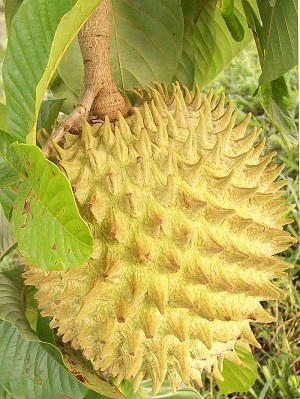
Rollinia – Brazilian Custard Apple A relative of the cherimoya this plant has its origins in tropical America. The fruit about 100mm in diameter has a creamy juicy and delicious flesh, according to some tasting like lemon meringue pie. Fruits within 4 years from seed. Seed selected from extremely sweet and flavoursome fruit with firm white flesh and few seeds. Other Names: Rollinia deliciosa, Biriba
** I have found this information about the Brazilian custard apple from various sources on the internet & there may be an overlap….ENJOY IT.
YES & I HAVE ADDED SOME VIDEOS OF ROLINIA FRUIT FOR VIEWING
The fruit so delicious they put it in the name! (Rollinia deliciosa)
Rollinia deliciosa is a species of flowering plant in the custard-apple family, Annonaceae, that is native to tropical South America. It is cultivated for its edible fruits, commonly known as biribá, lemon meringue pie fruit, or wild sugar-apple, throughout the world’s tropics and subtropics.
| Brazilian custard apple trees A wonderfully alien looking fruit, the Biriba is a large conical shaped fruit that ripens to a beautiful yellow color and has soft spines or protuberances all over the outer skin. Easily bruised when ripe, the interior pulp is creamy soft and sweet with a flavor resembling sweetened citrus custard. A medium sized, shallow rooted tree originally native to the Caribbean, Rollinia is well suited for container growing. It is easy and fast growing in the tropics and starts producing after only a few years. |
| location – Brazilian Custard Apple Trees can be grown in all 50 states simply by bringing indoors before temps drop below 40 degrees and providing lots of light. Most tropical fruit trees like Brazilian Custard Apple Trees are very fast growing and easier to maintain than domestic fruit trees. Below are a few brief tips for successful growth both indoors and out. |
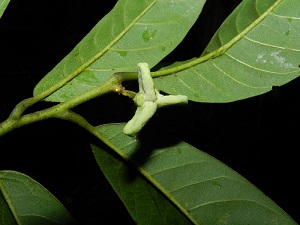
| Planting into ground -It requires space to stretch out, so plant your rows on 18 foot centers or for individual trees choose a location at least 10 feet from other trees or shrubs. |
| planting in pot – Brazilian Custard Apple Trees grow very well in containers as long as you provide an adequate size pot for root development. Select a pot 18-24 plus inches in diameter and 20 plus inches in height, with adequate drain holes. Glazed pots require far less watering than raw terracotta pots due to their porous nature. |
| soil – A well draining soil is of primary importance as Brazilian Custard Apple Trees roots do not like to be wet and will rot if allowed to sit in water for extended periods. A mixture of soil, sand and perlite is highly recommended for proper drainage. |
| indoor light – A bright and sunny solarium or window location with a more southern exposure is best for growth and fruit production. Many customers have reported harvesting fruit from trees that live in home and patio environments. |
| Outdoor light – Brazilian Custard Apple Trees prefer bright light and direct sun. If possible 12 hours of bright sun light is best for growth and fruit production though we have gotten remarkable results growing these trees in 30% shade year round. |
| Water – When watering Brazilian Custard Apple Trees make sure to lightly soak the soil and then do not water again until the top 2 inches are dry. Depending on light conditions, location and foliage watering may be required weekly or daily. Be sure to not over water, mucky soil will almost always cause decay and ultimately kill the tree. |
| Fertilizer – It is recommended that you fertilize at the same time as you water using a time released fertilizer 8-3-9 or similar to help your Brazilian Custard Apple Trees grow and produce a substantial crop. These trees are moderate feeders and may require multiple feeding during the growing season. It is important to follow the fertilizers labeled instructions as to not burn or kill the tree. |
Description/Taste
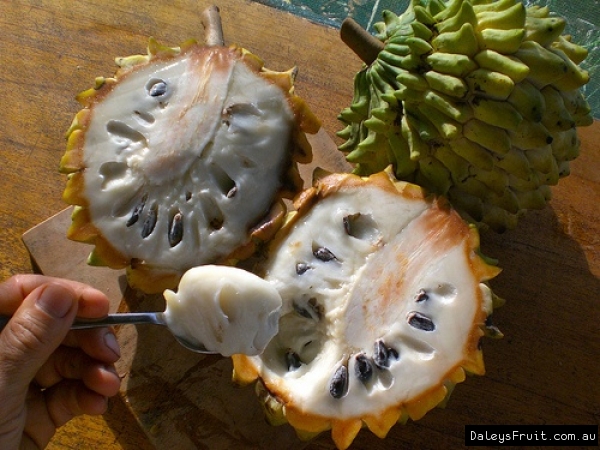
Rollinia fruit are heart-shaped or conical and can be anywhere from 5 to 20 centimeters in diameter. They have thick, woody stems that are extensions of the fruit’s core. The skin is covered in small, diamond shaped sections, each with a soft, spiky protuberance. Depending on the environment and the variety, the spines can be slight or quite prominent. The fruits mature from green to yellow, though they are often harvested when still green and will mature off the tree. Once mature, the spikes may turn black with excessive handling. The aromatic flesh is bright white or translucent with a gelatinous texture. It is fibreless with a smooth, almost creamy, consistency and contains small, inedible, dark brown, elliptical seeds. Rollinia fruit has a sweet-tart flavor with nuances of pineapple, banana, coconut, and other tropical flavors.
Seasons/Availability
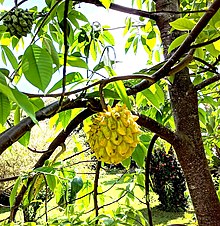
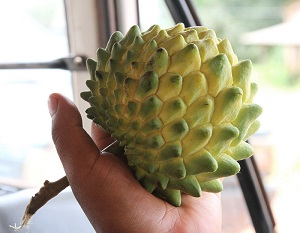
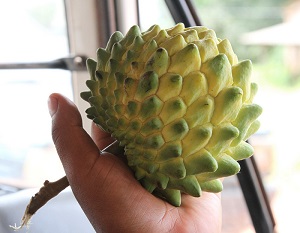
Rollinia fruit are available in the spring through the early summer months.
Current Facts
Rollinia fruit, also known as Biriba, is a large tropical fruit botanically known as Rollinia mucosa. It is a member of the Annonaceae family, which includes the soursop and cherimoya, two other so-called custard fruits. The unique fruits are often touted for their ‘lemon meringue pie’ flavor and are mostly found in the wild. They are popular in the Amazon region of South America and in Indonesia, especially on the island of Borneo.
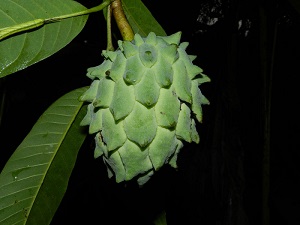
Nutritional Value
Rollinia fruit are high in calcium and phosphorus, as well as vitamin C and iron. Rollinia fruit are also a source of protein and carbohydrates, and contains important amino acids like lysine, methionine, threonine and tryptophan.
Applications
Rollinia fruit is usually eaten fresh or used in raw applications. Ripe fruits are easily sliced in half or into wedges. The pulp can be removed with a scoop or spoon, and the seeds discarded. The skin of a ripe Rollinia fruit will peel away easily. Toss Rollinia fruit with other fresh fruits. The pulp can be used to make jams or jellies or pureed for beverages or desserts. In Brazil, the pulp is mixed with milk for smoothies. It can be cooked into pies, cakes, or souffles. Rollinia fruit will keep for up to five days in the refrigerator. The fruits are highly perishable once ripe and yellow and should be used or refrigerated within one or two days.
Ethnic/Cultural Info
In its native Amazon, Rollinia fruit has been used for centuries for both medicinal and culinary purposes. In Brazil, the pulp of the Rollinia fruit is fermented to make wine. The fruit was used as a stimulant and to help cool the body when overheated and was consumed to prevent scurvy. The seeds were ground and used as a remedy for digestive issues. The hard, heavy wood of the Rollinia tree was used to make boat masts, boxes, and ribs for canoes.
Geography/History
Rollinia fruit is native to the western Amazon region of Peru and Brazil in South America, and grow at higher elevations. Their native range extends to Bolivia, Chile, Paraguay and Argentina, and north to Mexico. They were introduced to the United States from Brazil in 1908, and to the United States Department of Agriculture in 1914. They were taken to the Philippines sometime before 1915, though now they are mostly found in Borneo and Sumatra in Indonesia. Rollinia fruit can be found in Australia and Hawaii and may be found in parts of the Caribbean and at farmer’s markets in the southernmost parts of Florida.
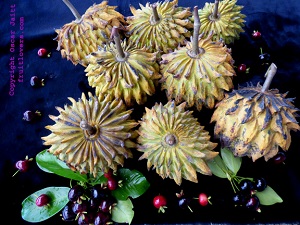
Scientific name
Rollinia mucosa (Jacq.) Baill.
Common names
The popular Brazilian name has been widely adopted, but in that country it may also be called biriba de Pernambuco, fruta da condessa, jaca de pobre, araticu, araticum, araticum pitaya. In Peru, it is anon; in Ecuador, chirimoya; in Colombia, mulato; in Venezuela, rinon or rinon de monte; in Mexico, anona babosa or zambo. In Trinidad it is called wild sugar apple; in Guadeloupe, cachiman morveux, cachiman cochon or cachiman montagne, in Puerto Rico, cachiman or anon cimarron, in the Dominican Republic, candongo or anona.
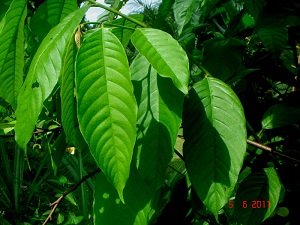
Synonyms
A. mucosa Jacq., R. deliciosa Saff., R. orthopetala A. DC., R. biflora Ruiz & Pav. ex G. Don, A. reticulata var. mucosa (Jacq.) Willd. 2
Relatives
Sugar apple (A. squamosa), cherimoya (A. cherimola), soursop (A. muricata), custard apple (A. reticulata), pond apple (A. glabra), ilama (A. diversifolia)
Family
Annonaceae
Origin
Originated in northern Brazil, Amazon; also found in Guiana, southern Mexico, Peru, and northern Argentina 3
USDA hardiness zones
10A-11
Uses
The fruit is eaten fresh and is fermented to make wine in Brazil
Height
13-50 ft (4-15 m)
Growth rate
Fast
Trunk/bark/branches
Dense, multiple-branched growth habit
Leaves
Alternate, deciduous, oblong-elliptic or ovate-oblong leaves, pointed at the apex, rounded at the base, 4 to 10 in (10-25 cm) long, thin but somewhat leathery and hairy on the underside 1
Flowers
Borne 1-3 in the leaf axils; hermaphroditic; 3/4-1 3/8 in (23.5 cm); triangular with 3 large fleshy outer petals and 3 rudimentary inner petals 1
Fruits
Are syncarp berries containing succulent, sweet pulp with many seeds: highly inconsistent in shape; turns green to yellow when ripe
Season
November and December
Light requirement
Prospers equally well in sun or shade
Soil tolerances
Calcareous soils do not seem to be unsuitable in Florida or Puerto Rico as long as they are moist 1
Drought tolerance
Will not tolerate drought
Cold tolerance
26.5 ºF (-3.10 ºC)
Invasive potential *
None reported
Pest resistance
Is attacked by chalcid fly mealybugs and scale
Known hazard
None known
Reading Material
Rollinia, University of Hawai’i at Mānoa pdf 6 pages
Rollinia deliciosa, Archives of the Rare Fruit Council of Australia
The Rollinia, Archives of the Rare Fruit Council of Australia
Biriba, Fruits of Warm Climates
Origin
This species has an extensive natural range, from Peru and northern Argentina, Paraguay and Brazil and northward to Guyana, Venezuela, Colombia and southern Mexico; Trinidad, the Lesser Antilles including Guadeloupe, Martinique and St. Vincent; and Puerto Rico and Hispaniola. It is much cultivated around Iquitos, Peru, and Rio de Janeiro, Brazil and the fruits are marketed in abundance. It is the favorite fruit in western Amazonia. 1
Description
The Rollinia is a rapid growing medium sized tree. It reaches a height of around 5 metres (16 ft) and has a spread of about 4 to 5 metres (13-16 ft) across. The tree is an attractive cone shape. The leaves are light green in colour, obovate-oblong and form to an average length of 30 cm and around 9 cm in width. The leaves are of a smooth texture with distinct veins at the back of the leaves like the rib bones of a fish. The veins are a slight yellow green in colour. The leaves hang off long slender branches which look like large feathers. 5
Flowers
The flowers, borne 1 to 3 or occasionally more together in the leaf axils, are hermaphroditic, 3/4 to 1 3/8 in (23.5 cm) wide; triangular, with 3 hairy sepals, 3 large, fleshy outer petals with upturned or horizontal wings, and 3 rudimentary inner petals. 1
Fruit
The fruit is conical to heart-shaped, or oblate; to 6 in (15 cm) in diameter; the rind yellow and composed of more or less hexagonal, conical segments, each tipped with a wart-like protrusion; nearly 1/8 in (3 mm) thick, leathery, tough and indehiscent. The pulp is white, mucilaginous, translucent, juicy, subacid to sweet. There is a slender, opaque-white core and numerous dark-brown, elliptic or obovate seeds 5/8 to 3/4 in (1.6-2 cm) long. 1
The somewhat fragile skin contains milky-white, pyramidal shaped carpels usually containing black seeds that average half an inch in length. 3
The yellow fruits have a juicy, melting flesh of a very pleasant flavour, reminiscent of lemon meringue pie. 6
Varieties
A few known cultivars include ‘Regard’ in the Philippines, ‘Prolific’ in Florida, and ‘Liso’ in Brazil. 3
Harvesting
Once harvested, the fruit will fully ripen in 5 to 8 days. As with many other Annonaceae, the fruit will have a short, less than 1 week, shelf life. Once the fruit skin turns fully black, the pulp color and viscosity changes to a clear mucous hence the botanic name, R. mucosa. At this stage, the fruit remains edible for only 1 or 2 days before fermentation begins. 3
Pollination
Biribá trees produce well without hand pollination, which is an advantage over many other Annonaceae.
Propagation
Rollinia is often propagated from seed, which should be planted as soon as possible after harvest. Preferably take seeds from trees that bear regularly with superior fruit.
Germination takes about a month and averages 80 percent success. Air-layering and grafting are possible.
Grafting onto rootstocks of A. montana or A. glabra causes dwarfing.
Planting
The tree grows best in deep, rich, organic soil and benefits form copious amounts of mulch as long as there is good drainage, but it tolerates poorer and highly acidic soils as long as there is sufficient water.
Pruning
The rapid growing tree needs to be pruned regularly to facilitate harvesting as well as for removal of dead wood. It’s also advisable to trim extremely long branches as the weight of multiple fruits can cause the branch to break.
Irrigation
Water is the most crucial element when trying to grow Rollinias. They are flood tolerant.
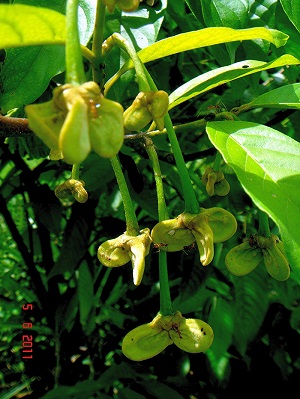
Pests
Few pest are found on healthy well cared for trees. Moth larva (Lepidopterene) can attack maturing fruit. A borer (Cratosomus bombina) burrows into the bark and trunk causing branch death. Once pruned, these branches should be burned or disposed of and not left in the field. White flies (Aleurodyscus cocois) and mealy bugs (Pseudococcus brevipes and Aspidiotus destructor) are found on leaves.
Diseases
Cercospora leaf spot occurs and Glomerella cingulata causes stem dieback and fruit rot.
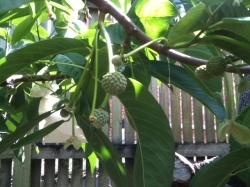
Food Uses
The fruit, often described as having a caramel or lemon-custard- pudding flavor, is usually eaten out of hand. It is often juiced in Brazil and sometimes blended with milk for a drink. It has also been made into wine. 3
Medicinal Properties
The fruit is regarded as refrigerant, analeptic and antiscorbutic. The powdered seeds are said to be a remedy for enterocolitis.
Other Uses (Indigenous)
The wood of the tree is yellow, hard, heavy, strong and is used for ribs for canoes, boat masts, boards and boxes. 1
Young Biriba trees are traditionally used as the main bow of the Afro-Brazilian instrument Berimbau, named after the Biriba tree.4
General
Of the approximately 65 species of the genus Rollinia (family Annonaceae), only a few have edible fruit and the best-known is the biriba, R. mucosa Baill. 1
Other members of the family that are grown for their fruit are:
Soursop (A. muricata)
Sugar apple (A. squamosa)
Ilama (A. diversifolia)
Custard Apple (A. reticulata)
Atemoya (A. cherimola x A. squamosa)
Poshte (A. scleroderma)
Cherimoya (A. cherimola)
Further Reading
Rollinia, Archives of the Rare Fruit Council of Australia
Any questions or if buying, contact me HERE

